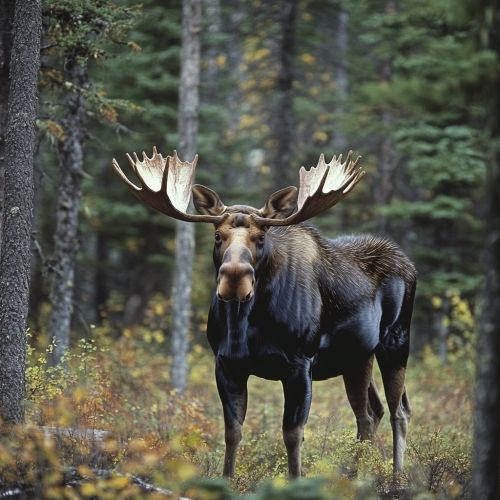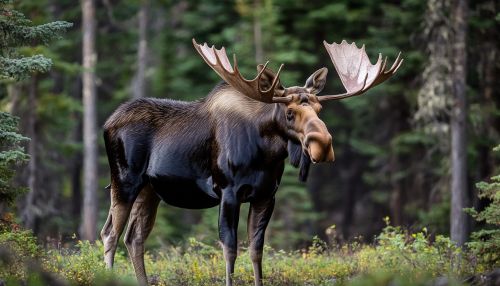Moose
Introduction
The moose, known scientifically as Alces alces, is the largest and heaviest extant species in the Cervidae. Native to the temperate and subarctic regions of the Northern Hemisphere, moose are primarily found in North America, Europe, and Asia. They are characterized by their massive size, distinctive antlers, and unique adaptations to cold environments. This article delves into the biology, ecology, behavior, and conservation of moose, providing a comprehensive overview of this remarkable species.
Taxonomy and Evolution
Moose belong to the order Artiodactyla, which includes even-toed ungulates such as deer, pigs, and camels. Within this order, they are part of the family Cervidae, which encompasses all deer species. The genus Alces is monotypic, meaning it contains only one species, Alces alces. However, there are several recognized subspecies, including the Alces alces gigas, the largest of all, and the Alces alces alces.
The evolutionary history of moose is traced back to the late Pleistocene, approximately 2 million years ago. Fossil records suggest that moose ancestors were smaller and less specialized than their modern descendants. Over time, they evolved to adapt to colder climates, developing features such as a thick coat and large body size to conserve heat.
Physical Characteristics
Moose are distinguished by their imposing stature, with males (bulls) typically weighing between 380 to 700 kilograms and standing about 1.4 to 2.1 meters at the shoulder. Females (cows) are generally smaller, weighing between 200 to 490 kilograms. The most iconic feature of the moose is the male's antlers, which can span up to 1.8 meters and weigh as much as 35 kilograms. These antlers are broad and palmate, a unique adaptation among deer.
The moose's coat is dense and insulating, varying in color from light brown to almost black, depending on the season and subspecies. Their long legs are well-suited for traversing deep snow and marshy terrain, while their large, sensitive noses are adapted for foraging in dense vegetation.


Habitat and Distribution
Moose inhabit boreal and mixed deciduous forests, preferring areas with abundant water sources such as lakes, rivers, and wetlands. Their range extends across the northern regions of North America, including Canada and the northern United States, as well as throughout Scandinavia, Russia, and parts of Eastern Europe.
The distribution of moose is heavily influenced by climatic conditions and the availability of suitable habitat. They are well-adapted to cold environments and are rarely found in regions where temperatures exceed 27 degrees Celsius. Seasonal migrations are common, with moose moving to higher elevations during the summer to escape heat and insects.
Diet and Foraging Behavior
Moose are herbivores, primarily feeding on leaves, twigs, bark, and aquatic vegetation. Their diet varies seasonally, with a preference for woody plants such as willows, birches, and aspens in the winter, and a shift to aquatic plants like water lilies and pondweed in the summer. Moose have a specialized digestive system, including a four-chambered stomach, which allows them to efficiently process fibrous plant material.
Foraging behavior is influenced by the need to balance energy intake with the risk of predation. Moose are known to browse at dawn and dusk, taking advantage of low light conditions to avoid predators. Their large size and powerful limbs enable them to reach high branches and strip bark from trees, accessing food sources unavailable to smaller herbivores.
Reproduction and Life Cycle
The breeding season, or rut, occurs in the autumn, typically from late September to early October. During this time, bulls compete for access to cows by engaging in displays of strength and vocalizations known as "rutting calls." Successful bulls will mate with multiple females, who give birth to one or two calves after a gestation period of approximately 230 days.
Calves are born in late spring and are highly dependent on their mothers for the first few months of life. They are weaned at around six months but often remain with their mothers until the following spring. Moose reach sexual maturity at around two years of age, although males may not successfully breed until they are older and larger.
Behavior and Social Structure
Moose are generally solitary animals, with social interactions primarily occurring during the breeding season. Outside of the rut, individuals maintain large home ranges and exhibit minimal territorial behavior. However, they may congregate in small groups during the winter to take advantage of limited food resources.
Communication among moose is facilitated through vocalizations, scent marking, and body language. Bulls are particularly vocal during the rut, using deep grunts and bellows to establish dominance and attract females. Scent marking involves the use of urine and glandular secretions to convey information about reproductive status and individual identity.
Predators and Threats
Moose face predation from several large carnivores, including wolves, bears, and cougars. Calves are particularly vulnerable, with predation accounting for a significant proportion of juvenile mortality. Adult moose are less susceptible to predation due to their size and strength, although they may still fall prey to packs of wolves or particularly large bears.
Human activities pose additional threats to moose populations. Habitat loss due to logging, agriculture, and urban development can reduce the availability of suitable habitat. Climate change is also a concern, as rising temperatures may lead to habitat shifts and increased parasite loads. Additionally, vehicle collisions are a significant cause of mortality in areas where roads intersect moose habitats.
Conservation and Management
Moose populations are generally stable across much of their range, although localized declines have been observed in some areas. Conservation efforts focus on habitat protection, sustainable hunting practices, and monitoring of population trends. In regions where moose are declining, management strategies may include habitat restoration, predator control, and the establishment of wildlife corridors.
In North America, moose are managed as a game species, with regulated hunting seasons and quotas designed to maintain healthy populations. In Europe, moose are protected under various national and international conservation agreements, reflecting their ecological and cultural significance.
Cultural Significance
Moose hold a prominent place in the cultures of many indigenous peoples across their range. They are revered as symbols of strength and resilience and play a central role in traditional hunting practices and ceremonies. In modern times, moose have become iconic symbols of wilderness and are featured in art, literature, and popular media.
